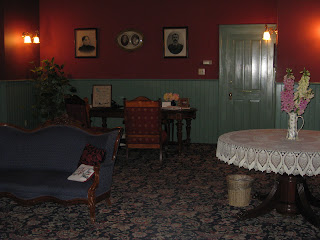We left Missoula in a rain/snow mix that threatened to accumulate to “Chains Required” levels over the high passes, so we decided to stick close to the Interstate System and major roads today. Our first intended stop was Philipsburg, reputedly one of the most perfectly preserved Victorian towns in Montana. However, it was located on a narrow side road that looked treacherous in snowy conditions, so we stopped instead in Deer Lodge, just off the I-15 Freeway. We took time to visit the Grant-Kohrs Ranch National Historic Site, located on the north edge of town. This is a working ranch of 1500 acres with 80 historic buildings, open to the public. The highlight is the 23-room ranch house, furnished in 1860s period, much as Conrad Kohrs, the “Cattle King of Montana”, might have decorated it.
Not far south on I-15 was the turnoff to Anaconda, a famed copper mining town and the seat of Deer Lodge County. MT-SR 1 was a divided highway, so we decided to brave the snow flurries and head west to the town. Anaconda retains many of the trappings representative of its former status as a prosperous copper mining city. One of its most prominent landmarks is the 1900 Deer Lodge County Courthouse, still in use today. Literally blocks of downtown have been placed on the National Register of Historic Places. Anaconda is also famous for the 585-foot-high Daly’s Copper Smelter Smokestack.
We returned to I-15 and headed into Butte, hoping to spend time walking its famed historic downtown. But at over 5700 feet in altitude, the weather in Butte thwarted our plans. It was snowing so heavily we feared we might not get over the high passes on the way to Bozeman, today’s destination. After we gassed up in a driving blizzard, we hastened out of Butte, vowing to return another time.
Since we now had extra time, we decided to explore the town of Three Forks, which is located on the Lewis and Clark Trail at the junction of the Madison, Gallatin and Jefferson rivers, considered the headwaters of the Missouri River. An attraction well worth a visit is the Headwaters Heritage Museum , located in a 1910 bank building.
We then headed east past Bozeman to Livingston, to pay a visit to its historic downtown. An outstanding museum is the Livingston Depot Center, located in the exquisitely restored 1902 Northern Pacific Railroad Station. The architects of the Grand Central Terminal in New York City, Reed & Stem, designed the Livingston Depot in Italian Renaissance style. In its heyday, Livingston was the gateway to Yellowstone National Park. After visiting the museum, we headed to Sacagawea Park, to view the rushing Yellowstone River, made famous by the 1992 film, A River Runs Through It. The water was flowing high due to rapid melting of the late snowfall.
 Architectural Details, Railroad Depot Museum,
Architectural Details, Railroad Depot Museum,Livingston, MT.
 Yellowstone River, as viewed from Sacagawea Park, Livingston.
Yellowstone River, as viewed from Sacagawea Park, Livingston.June 12, 2008
We awoke to a light snowfall that accumulated overnight; here we were nearly in mid-June and it still seemed like winter! Given the cold, chilly weather, we decided to take in one of Bozeman’s major attractions, The Museum of the Rockies, located on the campus of Montana State University. If one is interested in dinosaurs, this is one of the best museums we have seen devoted to these ancient creatures. Additionally, there are exhibits on Yellowstone National Park, Native-American and local history, and a planetarium.
We awoke to a light snowfall that accumulated overnight; here we were nearly in mid-June and it still seemed like winter! Given the cold, chilly weather, we decided to take in one of Bozeman’s major attractions, The Museum of the Rockies, located on the campus of Montana State University. If one is interested in dinosaurs, this is one of the best museums we have seen devoted to these ancient creatures. Additionally, there are exhibits on Yellowstone National Park, Native-American and local history, and a planetarium.
Kristi and Mike told us about a local institution, Wheat Montana Bakery and Deli, located at the junction of I-90 and US 287. We bought some rolls and six bear claws, to share at tomorrow’s breakfast. We then continued north on US 287 to Townsend, for a picnic lunch.
Our northernmost destination today was Helena, the state capital. We enjoyed visiting the small, but exquisite State Capitol with its stained glass and murals. Another worthwhile sight is the Cathedral of St. Helena, completed in 1914 in Gothic Victorian style. It reminded us of some of the great European cathedrals with its Carrara marble and stained glass windows. We then strolled in downtown Helena, including a visit to the Holter Museum of Art. This gallery features a wide variety of contemporary art in many media.

 Montana State Capitol, Helena.
Montana State Capitol, Helena."Driving the Golden Spike", painted by
Amedee Joullin (1862 - 1917), in 1903.
The weather cleared somewhat as we drove south on I-15, so we decided to detour onto MT-SR 69 and stop in Boulder. This tiny town has another impressive building, the Jefferson County Courthouse. Montana is full of hidden gems like this, if one takes the time to seek them out.
It was time to head back to Kristi & Mike's, with the intention of offering to take them and their two sons out to dinner for all the kindness they showed us. Instead, they sprang another surprise-tacos made from venison hunted by Mike! Kristi’s mother joined us for dinner. Another delightful evening of conversation was had by all!



















